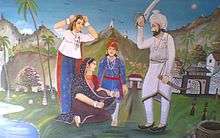Navaghana (king)
Navaghana was an early Chudasama king known only from the ballads and folklore of Saurashtra region of Gujarat, India. His capital was at Vamanasthali (now Vanthali near Junagadh, Gujarat, India). The bardic literature says his father Dyas was defeated by Patan Raja (probably Chaulukya king) and Navaghana was rescued. An Ahir named Devayat Bodar raised him and sacrificed his son to save Navaghana. When Navaghana grew up, he regained the throne with help of Ahirs. Another tale says that he defeated Hamir Sumro (probably Soomra ruler) of Sindh when he tried to forcefully capture Jahal, daughter of Devayat, for marriage.[1]
Bardic legends

Devayat Bodar
According to bardic tales, Navaghana's father Dyas was defeated and killed by the Patan Raja (probably the Chaulukya king of Anahilapataka) in the battle.[2][3][4] His young son Navaghana was rescued and taken to an Ahir named Devayat Bodar.[1][3][4]
Devayat raised Navaghana in secrecy. Once the governor of Saurashtra was informed about Navaghana so Devayat had to send his son Uga in his place who was then killed.[3][4]
When Navaghana became adult, the governor was invited to the marriage of Jahal, a daughter of Devayat. The governor and his men were killed by assembled Ahirs and Navaghana was raised to the throne.[3][4]
Hamir Soomra
Jahal was living with his husband in Sindh. The local ruler Hamir Soomra (probably of Soomra dynasty of Sindh) saw and fell in love with her and endeavoured to seize her but the Ahirs fled. Hamir Soomra pursued them and she sought aid from Navaghana and sent him some verses reminding him that her brother Uga's life had been given for him. Navaghana now marched on Sindh and defeated Hamir Soomra and rescued Jasal.[3][4][5][6]
He returned to Saurashtra and went to Dhari at which place he is said to have dropped a most valuable ring in the Galdharo Talav. In order to recover it, he tried but unsuccessfully to empty the tank. A local couplet records this attempt thus:[3][4]
999 Pavars Naghana employed, nevertheless the bottom was not, and the Galdharo was not a whit dismayed.
Ranchhodji Diwan, an author of the Tarikh-i-Sorath, writes that the army of Navaghana was composed of Rajputs, Ahirs, Kathis, Kolis and Khants.[3][4]
Dates and succession

Hemchandra's Dvyashraya and Merutunga's Prabandha-chintamani mentions later rulers of Junagadh, Navaghana and as Abhira Ranaka or Ahir Rana which is fairly applied as their ancestor regained the throne with help of Ahirs according to this bardic tales.[7]
It is difficult to decide the correct dates of the king as the information about him is derived only from bardic tales and folklore. According to the Gazetteer of the Bombay Presidency, Navaghana reigned from Vamanasthali from 1025–1044 CE and he was succeeded by his son Khengara who reigned for 23 years, followed by his son Navaghana.[3][4]
The construction of Navghan Kuvo, a well in the Uparkot Fort, is attributed to him. It is considered an oldest example of stepwell in Gujarat by some scholars.
References
- 1 2 Watson, James W. (1873). "Legends of the Earlier Chudasama Ras of Junagadh". Indian Antiquary. 2. pp. 312–317 – via HathiTrust Digital Library.

- ↑ Sree Padma (3 July 2014). Inventing and Reinventing the Goddess: Contemporary Iterations of Hindu Deities on the Move. Lexington Books. p. 189. ISBN 978-0-7391-9002-9.
- 1 2 3 4 5 6 7 8 Harold Wilberforce-Bell (1916). The History of Kathiawad from the Earliest Times. London: William Heinemann. pp. 54–83.

- 1 2 3 4 5 6 7 8 Watson, James W., ed. (1884). Gazetteer of the Bombay Presidency : Kathiawar. VIII. Bombay: Government Central Press. pp. 492–493.

- ↑ James Burgess (1876). "Girnar". Report on the Antiquities of Kathiawad and Kachh: Being the Result of the Second Season's Operations of the Archaeological Survey of Western India, 1874-75. pp. 163–165.
- ↑ Office of the Registrar General India (1965). Census of India, 1961: Gujarat. Manager of Publications. p. 276.
- ↑ Kumar, Sushil; Kumar, Naresh, eds. (2003). Encyclopaedia of folklore and folktales of South Asia. 10. Anmol Publications. p. 2771. ISBN 978-81-261-1400-9.